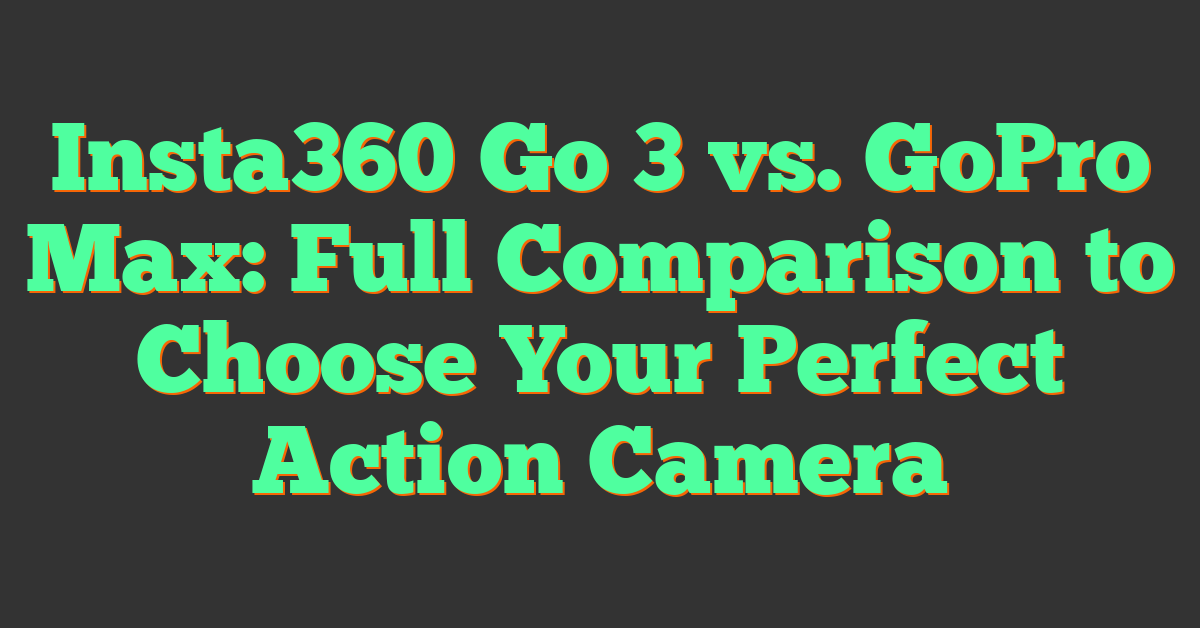Key Takeaways
- Unique Design Differences: The Insta360 Go 3 is ultra-compact (35g) with a magnetic build, while the GoPro Max is larger (154g) with dual lenses and a built-in touchscreen for professional-grade features.
- Video Quality and Stabilization: The GoPro Max offers 5.6K resolution with Max HyperSmooth stabilization for immersive 360-degree recording. In contrast, the Insta360 Go 3 provides 2.7K resolution with FlowState stabilization for casual, POV-style footage.
- Durability and Waterproofing: The GoPro Max has a rugged, waterproof design up to 16 feet, ideal for extreme conditions, while the Insta360 Go 3 is splashproof and requires accessories for water-based activities.
- Battery Life and Storage: The Insta360 Go 3’s Action Pod offers extended shooting time (up to 170 minutes) and built-in storage (up to 128GB), while the GoPro Max uses replaceable batteries and expandable microSD cards, supporting up to 256GB.
- Pricing and Target Users: The Insta360 Go 3 ($379.99) suits creators prioritizing portability, while the GoPro Max ($499.99) is a better fit for professionals seeking high-resolution 360-degree content and rugged durability.
- User Experience: The Insta360 app excels with AI editing tools and creative templates, while the GoPro Quik app offers advanced manual controls and reliable cloud integration for detailed projects.
Choosing the right action camera can be tough, especially with top contenders like the Insta360 Go 3 and GoPro Max. Both pack impressive features, but they cater to different needs and styles of capturing life’s moments. Whether you’re into compact portability or immersive 360-degree footage, these two cameras offer unique strengths.
I’ve spent time digging into what sets them apart—image quality, stabilization, design, and more. If you’re wondering which one suits your adventures best, stick around. By the end, you’ll have a clear idea of which camera deserves a spot in your gear bag.
Overview Of Insta360 Go 3 And GoPro Max
Insta360 Go 3 and GoPro Max represent two innovative approaches to action and 360-degree cameras. Each caters to distinct use cases with unique design philosophies and technological features.
The Insta360 Go 3 focuses on portability and simplicity. Weighing just 35g, it’s exceptionally lightweight, making it perfect for capturing on-the-go moments discreetly. It features a magnetic body that simplifies mounting on various surfaces, ideal for creative and compact setups. Its 2.7K video resolution provides sharp visuals, and FlowState stabilization ensures smooth footage for handheld or mounted shots.
The GoPro Max, however, provides an advanced 360-degree shooting experience. Its dual-lens setup records in 5.6K resolution, delivering exceptional video quality for immersive content. With its rugged build and water resistance up to 16 feet, it handles extreme environments easily. The Max Hypersmooth stabilization ensures remarkably steady footage, even during intense activities. It also offers intuitive features such as horizon leveling and PowerPano for 270-degree panoramic photos.
These cameras differ in size, capabilities, and usability. While Insta360 Go 3 prioritizes convenience and portability, GoPro Max excels in delivering high-end 360-degree content and durability geared for professionals and enthusiasts.
Design And Build Quality
The design and build quality of a camera significantly impact its usability in different shooting scenarios. Both the Insta360 Go 3 and GoPro Max cater to unique needs, offering contrasting form factors and durability features.
Size And Weight Comparison
The Insta360 Go 3 is compact and lightweight, weighing only 35g. Its pocket-sized form makes it ideal for capturing footage while on the move or mounting in tight spaces. I often appreciate its magnetic design, which simplifies mounting on metallic surfaces. For photographers needing discreet or wearable action cameras, this size is unmatched.
The GoPro Max, on the other hand, is larger and heavier at 154g. While it isn’t as compact as the Insta360 Go 3, its size accommodates advanced internals like dual lenses and a touchscreen. I see its weight as a tradeoff for enhanced performance, especially when capturing immersive 360-degree content or using it in professional environments.
| Camera | Weight | Key Feature |
|---|---|---|
| Insta360 Go 3 | 35g | Lightweight and compact with magnets. |
| GoPro Max | 154g | Larger with dual lenses and touchscreen. |
Durability And Waterproofing
« Ultimate Guide to Comparing All Types of 360 Cameras: Find the Perfect Fit for Your Needs
How to Select a 360 Camera for VR Content: Top Tips for Stunning Immersive Experiences »
The Insta360 Go 3’s construction is durable but not designed for extreme conditions. On its own, it’s water-resistant only up to an IPX4 rating (splashproof). To use it in water-based activities, I rely on additional protective accessories.
The GoPro Max excels in durability with its rugged design, boasting impressive waterproofing up to 16 feet (5 meters) without a case. This makes it suitable for underwater videography or shooting in rain without any extra housing. It’s engineered for flexibility, ensuring photographers and videographers have reliable equipment in more demanding environments.
| Camera | Waterproofing | Additional Durability Features |
|---|---|---|
| Insta360 Go 3 | IPX4 (splashproof) | Requires accessories for water usage. |
| GoPro Max | Up to 16 feet (5m) | Rugged and case-free waterproof design. |
I find the Insta360 Go 3 ideal for casual, lightweight applications, whereas the GoPro Max is better for rugged adventures or professional shoots involving water or challenging conditions.
Camera Performance
As someone deeply passionate about capturing immersive footage, I focus on how key performance aspects translate into real-world use. Both the Insta360 Go 3 and GoPro Max excel in various scenarios but cater to different priorities.
Image And Video Quality
The GoPro Max records in 5.6K resolution at 30fps, offering excellent clarity and detail for 360-degree and flat footage. Its wide dynamic range effectively handles high-contrast scenes, preserving highlights and shadows. In comparison, the Insta360 Go 3 captures video at 2.7K resolution at 30fps, delivering good quality for its size but less detail than the GoPro Max.
When it comes to still photography, the GoPro Max’s 16.6MP photos provide better resolution compared to the Go 3’s 9.2MP stills. The difference is noticeable, especially in landscape and VR content where detail matters. However, the Insta360 Go 3 excels in creative, on-the-go shooting with its minimalist interface and unique capture angles, ideal for POV-style videos.
Stabilization Features
Both cameras use advanced stabilization, but their implementations differ. The GoPro Max utilizes Max HyperSmooth, which provides gimbal-like stability for 360-degree and wide-angle modes. It smooths out intense motion reliably, even in high-impact activities like mountain biking or skiing.
The Insta360 Go 3 employs FlowState stabilization with horizon leveling, ensuring steady footage and keeping the horizon perfectly aligned. I find it effective for casual sports and dynamic motion shots, but the stabilization isn’t as robust for extreme vibrations compared to the GoPro Max. Additionally, the Go 3’s smaller size makes it easier to mount and use in unique positions, which can further enhance stabilization in creative setups.
Features And Functionality
Both the Insta360 Go 3 and GoPro Max offer unique functionalities designed to cater to different photography and videography needs. Understanding their standout features helps decide which is best suited for specific projects.
Unique Features Of Insta360 Go 3
The Insta360 Go 3 excels in portability and convenience. It weighs just 35g, and its compact, magnetic body allows for creative mounting on various surfaces, such as helmets or shirts. This feature makes it ideal for hands-free filming during activities like hiking or cycling.
The Go 3 includes a multifunctional Action Pod, which acts as both a remote control and a wireless display, allowing for live feed previews up to 5m away. With its 2.7K resolution and FlowState stabilization, it balances quality with versatility, fitting well into fast-paced, casual shooting scenarios.
Its Timed Capture mode allows users to schedule recordings, simplifying vlog-style shooting or capturing specific time-sensitive moments. The Horizon Lock capability ensures level frames, even in tilted or rotated camera positions.
Unique Features Of GoPro Max
The GoPro Max stands out with its dual-lens setup, enabling seamless 360-degree video capture in 5.6K resolution. This high resolution helps create immersive, detailed content suitable for VR and virtual tours. The single-lens Hero Mode transforms the Max into a traditional action camera, ideal for linear footage.
Its Max HyperSmooth stabilization ensures ultra-smooth footage during high-movement activities like skiing or mountain biking. It also integrates a Max TimeWarp feature, combining hyperlapse and real-time speed controls to produce dynamic, time-compressed videos.
Voice control enables hands-free operation, convenient for capturing footage when manual controls aren’t feasible. Additionally, its rugged build and waterproofing up to 16ft (5m) make the Max well-suited for underwater filming or harsh environments.
User Experience
Evaluating the user experience of both the Insta360 Go 3 and GoPro Max reveals key differences in their interfaces, usability, and supporting apps. These distinctions can significantly impact how photographers and videographers interact with these cameras during shoots.
Ease Of Use And Interface
The Insta360 Go 3 emphasizes simplicity. Its minimalist interface and compact size make it easy to navigate, even for beginners. The small magnetic body allows quick mounting in creative positions without the need for bulky accessories. Its multifunctional Action Pod acts as both a remote control and a screen, adding versatility for framing and control during recording. However, the smaller controls can be challenging for those with larger hands, especially during fast-paced setups.
The GoPro Max focuses on more advanced functionality. Its larger size accommodates a built-in touchscreen that simplifies navigation, offering a familiar DSLR-style interface. The dual-lens setup requires some adjustment for those new to 360-degree video capture, but experienced users appreciate the range of manual controls available. The voice control feature adds convenience, particularly when mounting the camera out of reach or in dynamic shooting scenarios.
App Connectivity And Software
Both cameras rely heavily on their companion apps, but the user experience they offer differs. The Insta360 app stands out for its AI-powered editing tools, which are perfect for creating polished 360 videos and photos quickly. Shot Lab provides pre-set templates to streamline complex edits, while features like Deep Track make subject tracking effortless. I find its user experience smooth, with a clear workflow for creating and sharing content across social platforms.
The GoPro Quik app focuses on robust editing and sharing. It provides advanced controls for 360-degree footage stitching and offers a variety of tools for manual adjustments. While Quik lacks some of the creative templates available in the Insta360 app, its precision and reliability in handling high-resolution footage are notable. The app’s cloud integration streamlines content backup, making it essential for longer shoots or travel setups.
Battery Life And Storage
Battery life and storage capacity play critical roles in choosing between the Insta360 Go 3 and GoPro Max, especially for photographers and videographers shooting long sessions or demanding 360-degree content.
Battery Performance
The Insta360 Go 3 integrates an impressive feature with its Action Pod, extending its runtime significantly. The camera itself offers about 45 minutes of standalone recording, but pairing it with the Action Pod increases total recording time to approximately 170 minutes. This dual-component setup enhances portability while delivering extended shooting capabilities, perfect for capturing creative, on-the-go footage.
The GoPro Max, designed with high-demand scenarios in mind, features a single battery rated at 1,600mAh. This allows it to record up to 85 minutes at its maximum 5.6K resolution, depending on environmental factors and usage settings like stabilization or Wi-Fi connectivity. Although not as long as the Go 3 with the Action Pod, its larger battery capacity ensures consistent power for events or detailed 360-degree projects.
Storage Options
The Insta360 Go 3 eliminates the need for external microSD cards by offering three built-in storage variants: 32GB, 64GB, and 128GB. This streamlined approach simplifies data management but may limit flexibility for those capturing extended video sequences in higher resolutions. For instance, the 32GB version holds short sessions but requires careful planning for longer shoots.
The GoPro Max relies on user-provided microSD cards, supporting capacities up to 256GB. This expandable storage option ensures ample space for extended 360-degree videos and high-resolution photos. It pairs well for those focused on professional workflows or shooting complex scenes where larger files are standard.
Price And Value For Money
Both the Insta360 Go 3 and GoPro Max are priced to reflect their features and target users, but their value depends on specific needs. The Insta360 Go 3 starts at $379.99 for the 32GB model, with higher storage options at incremental costs. Its portability, Action Pod versatility, and features like Timed Capture and Horizon Lock offer excellent value for creators prioritizing compact design and convenience.
The GoPro Max, priced around $499.99, includes advanced 360-degree video capabilities, Max HyperSmooth stabilization, and robust waterproofing. These features make it a better investment for those focusing on high-resolution 360 captures and extreme conditions. Its inclusion of microSD card compatibility also adds flexibility, especially for long shoots requiring extensive storage.
For budget-conscious users craving portability and simplicity, the Insta360 Go 3 stands out, while the GoPro Max’s premium price aligns with its professional-grade features. Evaluate your priorities to determine which camera offers the most value for your shooting style.
Conclusion
Choosing between the Insta360 Go 3 and GoPro Max ultimately depends on your priorities and shooting style. If you value portability, simplicity, and creative versatility, the Insta360 Go 3 is a fantastic option. On the other hand, the GoPro Max stands out with its advanced 360-degree capabilities, rugged build, and superior resolution, making it ideal for professionals and adventure enthusiasts.
Both cameras excel in their own ways, offering unique features tailored to different needs. Whether you’re capturing casual moments or creating high-end content, there’s a clear winner depending on your specific goals and budget.















